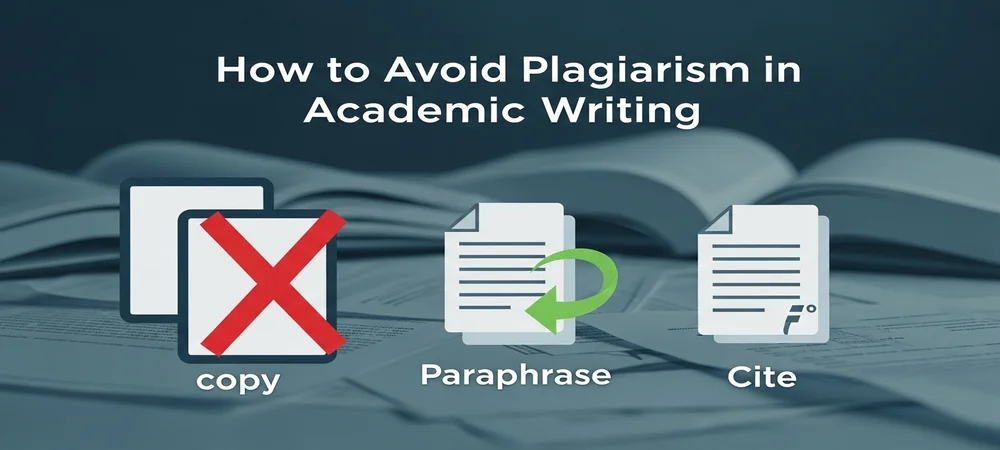How to Avoid Plagiarism in Academic Writing: A Complete Guide
Wed Oct 15 2025

Did you know that plagiarism affects 29% of high school students and 28% of college students? In an age where information is just a click away, unintentional plagiarism has become more common than ever. Whether you’re writing an essay, research paper, or thesis, understanding how to avoid plagiarism is essential to maintain academic integrity and originality.
In this guide, we’ll break down what plagiarism is, why it happens, and how you can avoid it through proper research, citation, and writing practices — so your work stays 100% authentic and credible.
In this article, we will learn how to avoid plagiarism through practical tips and effective strategies. Without further ado, let’s get in!
What is Plagiarism? Understanding the Basics
Plagiarism simply means copying someone else’s work or using their idea without giving credit. It can happen anywhere, whether you’re writing an essay, doing a project, or writing for an online post.
Below are different types of plagiarism:
- Verbatim plagiarism: This plagiarism refers to copying word-for-word without quotation marks or citation.
- Patchwriting plagiarism: It happens when you just change a few words but keep the original structure.
- Collusion Plagiarism: It means working with others when you’re supposed to work alone.
- Self-plagiarism: It means reusing your previous work without taking permission from your instructor.
With AI, when students or writers use ChatGPT to write their work without guidance, it also counts as plagiarism.
For example, copying a paragraph from Wikipedia without a proper citation falls under verbatim plagiarism. Meanwhile, paraphrasing without giving credit to the source is patchwriting.
Learning how not to plagiarize means always citing the sources you’re using, taking careful notes, and writing everything in your own words. This helps build your writing as credible and improves your academic writing skills.
Why Plagiarism is a Serious Offence: Academic and Legal Consequences
Plagiarism is a serious issue in universities. Using someone else’s work without credit can lead to failing grades, suspension, or even expulsion.
According to Harvard and Oxford guidelines, all sources must be acknowledged. Even accidental plagiarism can result in serious consequences. In fact, studies show that up to 60% of students admit to cheating and copying work in some way.
The good news is that plagiarism is avoidable. Always cite your sources, keep clear notes, and use plagiarism checkers to ensure accuracy. Plan your work carefully and ensure that you paraphrase correctly.
This guide provides effective advice to help you avoid plagiarism and protect your academic success, enabling you to write with confidence and integrity.
Common Mistakes Leading to Plagiarism
Many students plagiarize without intending to. Common mistakes include forgetting to cite a source, paraphrasing too closely, or copying ideas from classmates without proper attribution. This is called accidental plagiarism. For example, changing just a few words in a text still counts as patchwriting.
Students who don’t know how to take good notes make it worse. Poor note-taking makes it worse. If you mix your thoughts with the source, it’s easy to misattribute ideas. Some students also rely on online essays or buy papers, which is deliberate plagiarism.
By keeping organized notes and clearly citing sources, you can avoid these pitfalls and maintain academic integrity.
Step-by-Step Strategies to Avoid Plagiarism
Plagiarism might sound scary, but it can be avoided with some simple, practical steps. These strategies help you create original work and stay honest in your writing.
Effective Note-Taking Techniques
Good note-taking is one of the easiest ways to avoid plagiarism. Color-code your notes to separate your own ideas from sources. Always include the author, title, page number, or website link. Keep your thoughts in a separate section from copied material. This way, you’ll always know where your ideas came from, and citing becomes much easier. Organized notes also save you a lot of time when writing your paper.
Paraphrasing vs Quoting Properly
Learning to paraphrase and quote correctly is key. Paraphrasing means putting someone else’s ideas into your own words while keeping the meaning. Quoting uses the author’s exact words and needs quotation marks. Always add an in-text citation for both. Avoid Patchwriting; just swapping a few words still is plagiarism.
Using Citation & Reference Tools
Tools like EndNote, Zotero, and Scribbr make citing sources easier. They help you collect references, format citations, and automatically build a reference list. Using these tools reduces errors and ensures your work is in the correct academic style. They are especially helpful when managing many sources.
Maintaining a Source Trail & Organizing Drafts
Keep PDFs or printouts of all your sources and save each draft of your paper separately. This helps you track changes and see where every idea came from. A clear source trail makes checking references easier and prevents accidental plagiarism.
Avoiding Peer Work Copying & AI Misuse
Never copy a classmate’s work. Always give credit for the help or guidance you receive. If you use AI tools, check your university rules first. Misusing AI or collaborating incorrectly can still be considered plagiarism and may have serious consequences.
Additional Tips:
Plan your writing carefully. Start early to give yourself time to research, paraphrase, and cite properly. Before submitting, run your work through a plagiarism checker to catch any missed citations or accidental copying.
How to Cite Sources Correctly
A citation is the best way you can use to make your content plagiarism-free. It tells where you get that idea from, and you give credit to the author this way.
Below are the two types of citation you’re supposed to use in your work:
In-text citation: You used it in the main body of your text. It gives the idea that the information you’ve used isn’t yours, and you’re briefly referring to the original source. You cite in-text like this, (Smith, 2020). And when you directly quote something, you also need to include the page number.
Reference list: This is the list you see at the end of the research paper. In this list, you give detailed information about the sources you’ve used in your paper. Additionally, it helps the reader delve deeper into those ideas.
Meanwhile, the style of citation is a completely different thing. There are many, but the most common are the Harvard, APA, and IEEE styles. Each style has its own set of formatting rules for information. The type of citation you’re supposed to use depends on your academic discipline.
Digital Age Challenges: AI and Online Content
In today’s world, we use content from websites, blogs, and even AI tools. This makes plagiarism harder to spot but also easier to commit.
Plagiarism can be avoided by checking every online source. Always ask: Who wrote this? Is it reliable? If the author is unclear, look for a more reliable source.
If you use AI tools, don’t copy word-for-word. Instead, treat the output like notes, then rewrite in your own words.
Tips to avoid plagiarism online include verifying facts, adding citations, and keeping a record of every website you use.
Final Thoughts
Avoiding plagiarism is not only about rules. It is about respecting knowledge and developing your own academic voice. Every citation you add and every idea you develop shows honesty and growth.
Still, research and writing take time, and the process can feel overwhelming. This is where expert guidance makes a difference. With the right support, you can save hours of stress while maintaining the originality and credibility of your work.
Frequently Asked Questions
Q1: Can plagiarism be accidental?
Yes, it can. Sometimes it happens when you forget to cite a source, copy a sentence too closely, or miss quotation marks. Even if you didn’t mean to, it still counts as plagiarism.
Q2: How do I paraphrase without plagiarizing?
First, read the original text and then set it aside. Rewrite the idea in your own words, using a different sentence structure. Don’t just swap a few words. And remember always include an in-text citation.
Q3: What are the best ways to avoid plagiarism?
Stay organized with your notes, paraphrase carefully, quote only when needed, and make sure every source is cited both in the text and in your reference list.
Q4: Do I need to cite common knowledge?
No. If it’s something most people know, like “Water freezes at 0°C,” you don’t need a citation. But if the fact is specific, uncommon, or could be debated, then cite your source.
Q5: What tools can help me check for plagiarism?
Popular tools like Turnitin, Grammarly, and Scribbr can scan your work and compare it with huge databases. They’re great for spotting overlaps you might have missed.
Q6: Can I reuse my own work without citing it?
Not without permission. Reusing parts of your old assignments is called self-plagiarism. If you want to do this, always check with your instructor first.
Tags:

Subscribe Now & Get Exclusive Industry Insights!
By clicking submit button, you agree to our privacy Policy
